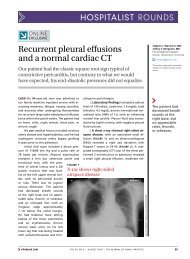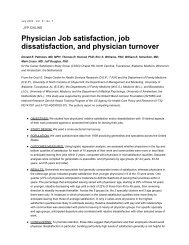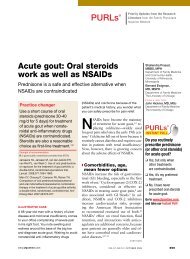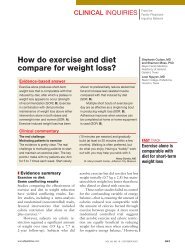Clinical Inquiries - The Journal of Family Practice
Clinical Inquiries - The Journal of Family Practice
Clinical Inquiries - The Journal of Family Practice
You also want an ePaper? Increase the reach of your titles
YUMPU automatically turns print PDFs into web optimized ePapers that Google loves.
Applied<br />
FIGURE 2<br />
NOT IMPROVED<br />
Continue initial therapy<br />
Tension night splinting<br />
Prescription orthoses<br />
Casting<br />
Cam walker<br />
Corticosteroid injection<br />
NOT IMPROVED<br />
Continue existing therapy<br />
Casting/immobilization<br />
Extracorporeal shock<br />
wave therapy<br />
Consider surgery<br />
■ CLINICAL COMMENTARY<br />
Keys to treatment: Avoid overuse,<br />
stabilize, be patient<br />
Plantar fasciitis (heel pain syndrome) is one <strong>of</strong><br />
the most common disorders <strong>of</strong> the foot and<br />
ankle and is notoriously difficult to treat.<br />
Patients are commonly symptomatic for<br />
months, leading to frustration, poor compliance,<br />
and general dissatisfaction.<br />
From a pathophysiologic perspective, plantar<br />
fasciitis is a form <strong>of</strong> overuse syndrome. When<br />
approached in this manner, it makes intuitive<br />
(and now scientific) sense that stabilization <strong>of</strong><br />
the proximal fascial enthesis at the point <strong>of</strong> its<br />
insertion to the calcaneus is the key to clinical<br />
resolution <strong>of</strong> symptoms. Activity modification,<br />
716 SEPTEMBER 2003 / VOL 52, NO 9 · <strong>The</strong> <strong>Journal</strong> <strong>of</strong> <strong>Family</strong> <strong>Practice</strong><br />
CLINICAL INQUIRIES<br />
Treatment <strong>of</strong> plantar fasciitis<br />
Limit <strong>of</strong>fending activities<br />
Wear supportive footwear<br />
Lose weight<br />
Stretch calf muscles<br />
Viscoelastic heel cups<br />
Padding and taping<br />
Nonsteroidal anti-inflammatory drugs<br />
Corticosteroid injection<br />
IMPROVED<br />
Continue to resolution<br />
Continue to resolution<br />
IMPROVED<br />
mechanical therapy, and patience are the essential<br />
elements for treating plantar fasciitis.<br />
Mark B. Stephens, MD, MS, Uniformed Services<br />
University <strong>of</strong> the Health Sciences, Bethesda, Md<br />
REFERENCES<br />
1. Lynch DM, G<strong>of</strong>orth WP, Martin JE, Odom RD, Preece CK,<br />
Kotter MW. Conservative treatment <strong>of</strong> plantar fasciitis. A<br />
prospective study. J Am Podiatr Med Assoc 1998;<br />
88:375–380.<br />
2. Martin RL, Irrgang JJ, Conti SF. Outcome study <strong>of</strong> subjects<br />
with insertional plantar fasciitis. Foot Ankle Int 1998;<br />
19:803–811.<br />
3. Probe RA, Baca M, Adams R, Preece C. Night splint treatment<br />
for plantar fasciitis. A prospective randomized study.<br />
Clin Orthop 1999; 368:190–195.<br />
4. Martin JE, Hosch JC, G<strong>of</strong>orth WP, Murff RT, Lynch DM,<br />
Odom RD. Mechanical treatment <strong>of</strong> plantar fasciitis:<br />
A prospective study. J Am Podiatr Med Assoc 2001;<br />
91:55–62.<br />
5. Rompe JD, Schoellner C, Nafe B. Evaluation <strong>of</strong> low-energy








